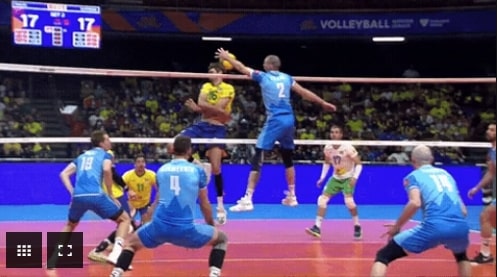History of Men’s Volleyball

The History of Men’s Volleyball: Key Moments and Figures
Men’s volleyball has grown from a local recreational activity to an internationally renowned sport with millions of fans. The sport’s journey spans over a century, marked by pivotal moments, influential players and evolving rules that shaped the game as we know it today.
Here is a look at the history of men’s volleyball, highlighting significant events and figures that have contributed to its development and popularity.
Early Beginnings (1895-1920)
Volleyball was invented in 1895 by William G. Morgan, a YMCA physical education director in Holyoke, Massachusetts. Originally called “Mintonette,” Morgan designed it as an indoor sport for older YMCA members seeking a less physically intense alternative to basketball.
The first net was borrowed from tennis, standing at about 6 feet, 6 inches high, which was slightly above average men’s height at the time.
In 1896, during a demonstration at Springfield College, a faculty member noted the volleying nature of the game and suggested renaming it “volleyball.” As the game spread through the YMCA network, it quickly gained popularity across the United States and, by World War I, had spread internationally due to American troops.
The Formation of Rules and Governance (1920-1940)
As volleyball spread, a standardized set of rules became essential. By the 1920s, the sport’s growth led to the formation of the United States Volleyball Association (USVBA), which later became USA Volleyball. The organization took on the task of managing rules and organizing tournaments, establishing a structured foundation for the sport in the United States.
The introduction of a three-hit rule in 1920 was a key development, shaping volleyball as a team based sport where players relied on strategic passing, setting and spiking. This rule added an element of teamwork, a defining characteristic that distinguishes volleyball from other net sports.
The 1930s saw the first official men’s volleyball competitions. In 1936, an International Volleyball Federation was discussed in Warsaw. Although World War II delayed formal international organization, volleyball’s foundation had been laid.
The Establishment of the FIVB and First World Championship (1947-1949)
In 1947, the Federation Internationale de Volleyball (FIVB) was established in Paris, France, with 14 founding nations. This governing body united volleyball’s rules and brought together countries interested in further developing and formalizing the sport globally.
The FIVB’s formation led to the first Men’s World Championship in 1949 in Prague, Czechoslovakia. The Soviet Union emerged victorious, beginning its legacy as a dominant force in men’s volleyball. This event marked the first international men’s volleyball tournament and set the stage for future competitions, helping establish volleyball as a competitive sport.
Olympic Inclusion and Expansion (1964)
One of the most significant moments in volleyball history was its inclusion in the Olympic Games. In 1964, volleyball made its Olympic debut in Tokyo, Japan, for both men and women. The Soviet Union won the first Olympic men’s volleyball gold medal, defeating Czechoslovakia in the finals, while Japan took bronze.
The Olympic inclusion catapulted volleyball’s popularity worldwide. The game’s visibility on a global stage attracted fans and inspired nations to invest in training programs and facilities. Players like Konstantin Reva and Vyacheslav Zaytsev of the Soviet Union became prominent figures, helping their team dominate international competitions for years.
The Evolution of Strategy and the Dominance of Powerhouses (1970s-1980s)
The 1970s and 1980s saw tactical advancements and changes in playing style. Teams such as the Soviet Union, Japan, Poland and Brazil pioneered various techniques, including advanced setting, blocking strategies and the introduction of specialized roles like the setter and libero.
One of the most pivotal moments in this era was Poland’s victory at the 1974 FIVB World Championship and the 1976 Olympics. Polish players like Edward Skorek and Stanislaw Gosciniak gained international fame for their skill, helping elevate Poland to prominence.
Meanwhile, Japan continued to innovate, focusing on defensive agility, which became known as the “Japanese style,” characterized by quick, low sets and defensive coverage.
The United States also began to make its mark on the volleyball world. The U.S. team, led by coach Doug Beal and featuring stars like Karch Kiraly, Steve Timmons and Dusty Dvorak, revolutionized the game by emphasizing a combination of power and agility.
The U.S. men’s team would go on to win their first Olympic gold medal in 1984 in Los Angeles, establishing the country as a new volleyball powerhouse.
The Professionalization of Volleyball and Key Players (1990s)
The 1990s marked a turning point for men’s volleyball, as the sport saw increased professionalization and commercialization. The establishment of professional leagues in Europe, such as Italy’s Serie A1, attracted talent from around the world and provided a platform for athletes to compete professionally.
Several players from this period left a lasting legacy, including Brazil’s Giba, widely regarded as one of the best players in volleyball history. Known for his powerful spikes and leadership, Giba led Brazil to multiple World Championships and an Olympic gold in 2004.
Other notable players from the 1990s and early 2000s include Andrea Giani of Italy, who helped Italy win three consecutive World Championships and Lorenzo Bernardi, whose skill and versatility earned him the nickname “Mister Secolo” or “Mr. Century.”
Modern Innovations and the Rise of New Nations (2000-Present)
In the 21st century, volleyball has continued to evolve with new rules and styles of play. In 1999, the FIVB introduced the rally scoring system, which meant that a point could be scored on every rally, regardless of which team served. This change made the game faster and more viewer friendly, adding excitement for both fans and players.
Technological advancements have also influenced volleyball, with the introduction of video challenges to review disputed calls. Players are now more specialized, with taller players focusing on blocking and spiking, while shorter, quicker players excel as liberos and setters.
In recent years, teams like Russia, Brazil and Poland have remained at the top of international competitions, while countries like the United States, France and Italy continue to produce world class players and achieve success on the international stage.
France’s Earvin N’Gapeth and Poland’s Wilfredo León are standout players known for their athleticism, innovative playing styles and impressive technical skills, keeping fans captivated.
Key Figures in Men’s Volleyball History
In Closing
From its origins as a YMCA activity to an Olympic sport watched by millions, men’s volleyball has come a long way. Key figures like William G. Morgan, Karch Kiraly, Giba and Wilfredo León have shaped the sport, inspiring generations of players.
The continuous evolution of strategy, rules and technology promises an exciting future, ensuring that men’s volleyball will remain a thrilling and globally cherished sport for years to come.


